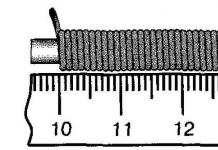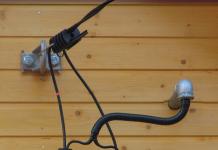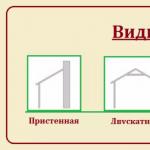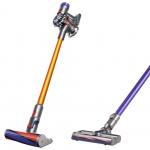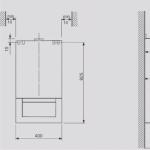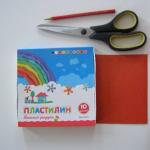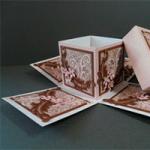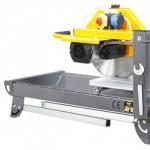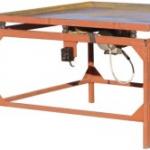Samsonova Larisa
"Lighthouse" craft for children 5-6 years old.
Target: develop creativity children. Tasks: 1. Teach to see the potential for transformation in ordinary objects. 2. Learn to draw up a work plan and implement it independently. 3. Strengthen the skill of rolling and flattening sausages from plasticine. 4. Strengthen the skill of cutting along the intended line. Strengthen the skill of smearing children. 5. Learn to evaluate your work.

To work, you will need a plastic bottle of yogurt, kefir or milk, plasticine, red cardboard, a pencil, and scissors. Remember with your children what it is lighthouse. What is it for, what parts does it have. Offer to choose from waste material what might be needed for work. Make a work plan.

Remove the label from the bottle and degrease it.

Place the bottle on colored cardboard and trace the base. To this circle add another circle 1.5 - 2 cm larger. This is the future bridge for the caretaker lighthouse. Add another circle 1 cm larger. This is the bridge railing. From the center of the circle, draw cutting lines to the first circle. Mark the cut lines where the railing would be.

Cut out the part. Bend the piece along the cut line.

Shorten the internal sectors of the part.

Roll out long sausages from red plasticine and flatten them. Roll thin sausages for windows from blue plasticine. Connect them into round windows.

Using the smearing method, secure the plasticine to the bottle.

Place the bridge piece on the top of the bottle and secure it with plasticine.
Publications on the topic:
Our Kola Peninsula is the northern region of Russia. The northern region is harsh, but how amazing, bewitchingly beautiful and unique it is.
It's time for snowdrops to wake up in March, opening their eyes towards spring. It was not easy for them to wait in the cold for the turquoise of the sky to brighten.
I warmly welcome YOU, DEAR COLLEAGUES! The frost crackles and kisses your cheeks, The snow is like granulated sugar, And an angel flies in the clear and high sky.
The coldest time of the year is Winter, the time of snowstorms and bitter frosts. At the same time, winter is the favorite time of the year for most. It's winter after all.
Goal: to generalize and expand children’s knowledge about three-dimensional crafts made from waste material (bobbins). Objectives: 1. Teach children how to do three-dimensional crafts.
The most interesting, colorful and magical holiday is approaching, which adults and children are looking forward to. Children believe in fairy tales and look forward to it.
February 23 is coming soon, every year all teachers have a headache, what kind of gift to make for dads and grandfathers this time. I offer you a master.
1. You will need four garden pots, each slightly smaller than the previous one. We first clean and wash old and dirty pots.
2. Paint the rims of three pots, except the smallest one, with acrylic paint. I chose white. We paint in three stages, allowing the paint to dry thoroughly.
3. We also paint the “body” of the pots in three layers. I chose bright red.
4.Using black paint and a small brush, paint windows on the pots (to make it more neat, you can use a stencil).
5. Paint the remaining small pot and two saucers on both sides in a bright inky color. This is the top of the lighthouse.
6.Applying glue to the bottoms and rims of the pots, glue them to each other.
7. Carefully glue the saucer to the top bottom and place a decorative candle on it without a flame (battery-powered). Cover with a second saucer and glue a small pot to the very top.
Making a garden figurine: photo
On a note:
The cycle of pots in nature
The flowers grow, I transplant them into large containers, and I wash the old pots with soap and bathe them in very hot water, almost boiling water. For cleaning I use old toothbrushes and dish sponges. After this, no infection will stick to them.
Then I store the clean pots in a bag on a rack. My friend has a dishwasher, so once a year she fills it with flower pots, turns the temperature to 70 degrees and dies. After this the pots are as good as new.
The neighbor has a different method. She makes it like a nesting doll, puts it in a bucket and fills it with water with the addition of vinegar. He closes the bucket and keeps it like that for a day. Then it rinses and dries. The acid is good at removing limescale on pots and mold. And the smell of vinegar disappears quickly.
DIY garden figurine for a flower bed
We are talking about figurines of animals, birds, butterflies, etc., which are stuck into the ground near perennial bushes, flowers, or just on the lawn and look very beautiful, enlivening the landscape.
To do this you need:
Draw the outline of the future figure on paper, fitting it into an approximate size of 300x200 mm.
Transfer the drawing to a waterproof material - OSB board 6-8 mm thick (offcuts can be found at a construction site where renovations are underway). Alternatively, you can use a more affordable material - fiberboard, also in the form of scraps.
Using a jigsaw, cut out an image of the future product along the contour.
Thoroughly saturate the product with waste oil or hot drying oil, especially the end parts.
At the very bottom of the product, drill a 3 mm hole and 5-7 cm deep and insert a 3 mm wire (you can use welding electrode 3 without coating).
Prime the product with white PF paint and after drying, paint it at the author’s discretion with colored paints for exterior use.
Instead of oil paints, you can use gouache paints, but be sure to fix them with waterproof varnish in two layers after painting the decorative item and let it dry. Under gouache paints, the product should be primed with white water-based paint for outdoor use. I wish you creative success!
K. Redkin
© Elena Lyadova Omsk
So summer is over. Many of us have vacationed at sea, and on the seashores you can often see such a structure as a lighthouse. A lighthouse is a tower with a bright light at the top, located on an important or dangerous part of a waterway. Lighthouses help with navigation and warn ships of danger. A lighthouse is a road sign at sea. They are usually built on high capes of the mainland or large islands protruding into the sea, as well as on islands located far from the coast or simply on an underwater rock. Let’s try, with the help of adults and this master class, to make a real home lighthouse with our own hands!
The work will not be difficult and for it we will need:
1. Cardboard cylindrical box (you can take a box of chips);
2. Juice bag;
3. Old newspapers;
4. Plastic transparent yogurt jar;
5. Screw-on tin lid;
6. White water-based paint;
7. Gouache paints, brush, pencil;
8. PVA glue;
9. Adhesive Moment transparent;

First, glue our cylinder (actually, this will be the lighthouse itself) onto a juice bag with Moment glue (the bag is the base on which it will stand). 
Next, we take old newspapers and crumple them well. 
Around the lighthouse, using PVA glue (you will need quite a lot of glue), glue crumpled newspapers onto a juice box (crumpled newspapers will create the effect of stones smoothly turning into sea waves).

Let our design dry thoroughly. 
After the work has dried, completely cover it with white water-based paint. This paint is good because its consistency is quite thick, and in order for the black newspaper font not to show through, applying one layer of this paint is enough.

As soon as the white paint dries, and it dries quite quickly, we move on to the next stage of work. Let's draw a drawing with a simple pencil. 
We paint the lighthouse itself with colored gouache paints: we draw red stripes on it, and also paint the area directly next to it yellow (this is sand), then black (these are sea stones), and paint the last layer blue or cyan (sea waves).




Let the paints dry well. 
While the work is drying, glue the tin lid onto a plastic transparent yogurt jar. If you don't have a clear plastic jar, you can use a small glass jar. 

And let's paint it red. 
We put the jar on the top of the lighthouse. 
There is no need to glue the jar to the top of the lighthouse, and here's why: since the cylinder from which our lighthouse is made is empty in the middle, you can insert a small thin flashlight into it, if, of course, you have one in the house, and turn it on periodically in the evenings. The light will penetrate through the transparent jar and our craft will become a real glowing home beacon!
Almost every person is intimately familiar with the navigation system. GPS helps to quickly and accurately determine the location of a specific object - a person, car, other modes of transport or animals. The simplest beacon is inexpensive in the store, but a more powerful one takes a bit of a toll on your wallet. But why buy if you can really make it yourself? From what and how will those who wish to learn now.
Self-assembly of a GPS beacon, what to make it from, how to proceed
ATTENTION! A completely simple way to reduce fuel consumption has been found! Don't believe me? An auto mechanic with 15 years of experience also didn’t believe it until he tried it. And now he saves 35,000 rubles a year on gasoline!
Every modern phone, car, and computer has a GPS beacon. The program is convenient, simple, and most importantly productive. The location of any object is determined instantly with its help. A GPS beacon, as an independent device, is popular among motorists and parents who constantly want to know where their child is, but not everyone is in a hurry to shell out their money in the store for this device. For such thrifty people, there are ideas that will help them construct a GPS tracking beacon on their own and at minimal cost. There are several ways to make a tracking beacon with your own hands, and these are the ones we will talk about now.
Owners of cool smartphones will receive a tracking system for free and without effort
Every smartphone that has a built-in GPS module can become a full-fledged beacon that a person can use to obtain the coordinates he needs. The entire technical aspect of creating such a beacon is as follows:

After these steps, the owner of the smartphone will be able to use his device not only for calls, entertainment and access to the Internet, but also to track the location of a specific object. In this simple way, a smartphone turns into a full-fledged GPS beacon.
For the system to work correctly, the Android device must have a version no lower than 3.2, but it is better if it is no lower than 4.1.2. Data about the tracked object will be displayed on the phone in the form of SMS messages or points on Google Maps.
How to mount a GPS beacon using a less sophisticated mobile device
A phone that is slightly inferior to powerful mobile devices on the Android operating system too  can become an excellent basis for a GPS beacon. To assemble such a device with your own hands, you will need to buy something else and show your skills in handling technical devices. In addition to the phone, you will need to stock up on an adapter - it could be a broken charger, where the side connected to the phone has survived. You will also need to buy a GPS/GPRS module and receiver.
can become an excellent basis for a GPS beacon. To assemble such a device with your own hands, you will need to buy something else and show your skills in handling technical devices. In addition to the phone, you will need to stock up on an adapter - it could be a broken charger, where the side connected to the phone has survived. You will also need to buy a GPS/GPRS module and receiver.
If all the elements of the future lighthouse are at hand, you need to stock up on tools - a knife, a soldering iron. The work must be carried out according to the following principle:
- the wires that form the basis of the cable for connecting to the phone need to be stripped;
- they must be connected to the module or using a soldering iron;
- connect the system to the phone socket, which is intended for charging;
- turn on the receiver and try to configure the necessary parameters from your phone.
Such a GPS beacon will send signals to the phone in the form of regular text messages, and if it is possible to open maps, it will be easier to look at the coordinates on them, because this will make it easier to navigate in space and determine the specific location of the object.
This beacon is easy to use, but at home. The design will be quite inconvenient to carry or install in a car. This is an ideal option for those who are going to keep an eye on their loved ones and children from home.
Is it possible to make a beacon without a phone?
Before answering the question of whether it is possible to make a GPS beacon with your own hands without a phone, you should understand what this device actually is and what features it has. GPS beacon is a device that is mainly used to protect cars. It has a compact size and is powered by charging. The system accurately determines the location of the object, but for it to work correctly, a SIM card must be present inside the device. 
The last fact makes it possible to understand that the operation of a beacon without a SIM card is not possible. In this case, there are only two ways out of the situation - buy a ready-made beacon in a store or make it yourself using a mobile phone and additional components. If the SIM card is missing, the system will not be able to perform the following actions:
- correct and timely signal transmission;
- registration of a new tracking object and display of statements about it;
- Connect to the Internet - this is necessary for the GPS to work.
If you are using a phone with the latest operating system and a powerful processor, you just need to download a special application, while a simpler model requires additional elements to work in GPS beacon mode.
Advantages and disadvantages of a DIY GPS beacon
Even store-bought technical devices have a number of advantages and disadvantages. If we talk about a do-it-yourself GPS dome, its positive aspects are as follows:
- the ability to quickly, without outside help and large financial investments, make a reliable tracking device;
- even if you have to buy additional little things to construct the lighthouse, it will be much cheaper than in the store;
- In terms of functionality, such a device is in no way inferior to beacons that were bought in a store.
A person will be able to use such a beacon for many years, and if any inaccuracies arise in the work, they can always be corrected.
A beacon for cars created with one’s own hands has a number of disadvantages that make it inferior in popularity to the standard version bought in a store. These negative aspects are especially noticeable for car owners and are as follows:
- due to the design features of the system, it cannot be correctly placed in the car;
- Part of such a beacon must necessarily be a mobile device, and the constant tracking process can create difficulties for mobile communications;
- The beacon consists of several elements connected to each other, and when the car moves, they may become disconnected from each other or the wires may break.
If a person plans to use a beacon for receiving GPS data for his car, then it is better to buy this device in a store. When a tracking system is needed exclusively for home use, a do-it-yourself beacon will be an ideal option. The frequent use of such systems for cars prompted the creators to develop a monoblock design of compact dimensions. If you make an analogue of a beacon yourself using only a smartphone and a special program, you can use it for placement in a car. If the lighthouse is created from separate elements, it is better to leave it for home use.
A GPS beacon will always help you search for cars or other moving objects. You can buy it in a store or create it yourself. It is worth deciding which option to choose, taking into account your own financial capabilities, the purpose for which the device will be used and soberly assessing your communication skills with technical devices.
WE WANT TO THROW OUT: coffee cans, newspaper (or paper egg cartons)
WILL DO: decorative figurine "Lighthouse"
The sea season seems to be over, but the ideas remain. And I suggest you save tin cans in order to build a guiding lighthouse for the new season. The photo shows a small structure made from coffee cans for the home, but you can build a similar one from larger cans for the garden.
Crafts on a "marine" theme. And, of course, we use everything unnecessary...
This craft can be simply a decorative element at home or in the garden. Or maybe a toy for children.
But if you wish, you can turn it into a lamp: only carefully, with the participation of an electrician and using a special “non-heating” light bulb. Well, or use an LED candle.

"Lighthouse" with your own hands.
WE WILL NEED:
1. Acrylic paints + varnish.
2. "Liquid nails" for joining cans.
3. Brushes.
4. Wire from "Champagne" - for handrails.

PROGRESS:
1-2. Clean the jars with sandpaper. We customize the design: cut holes where necessary.
3. We mold the missing parts - the roof, lifebuoys, stones - from paper dough (papier-mâché). Let's dry it.
4. We paint.
5.Assemble and decorate.
Don't forget about varnish, and for use in the garden - yacht varnish.
Note: the “weathervane” can be cut from a tin can.
FOR THOSE WHO LIKE SIMPLE:
But, in general, you can get by with just tin cans: connect them using liquid nails or glue. All “decor” (stones, windows, etc.) should be drawn or pasted on (decoupage). And instead of the roof, insert a suitable (!) solar-powered garden lantern.
